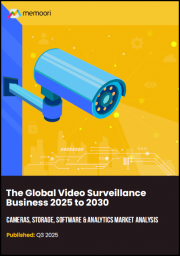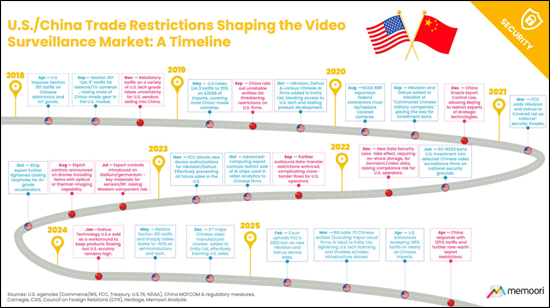
|
시장보고서
상품코드
1848180
세계의 비디오 감시 시장(2025-2030년)The Global Video Surveillance Business 2025 to 2030 - Cameras, Storage, Software & Analytics Market Analysis |
||||||

- 세계 비디오 감시 장비 및 소프트웨어의 총 수익은 공장 출하 가격으로 2024년 338억 달러에 이르렀고, 2025년 355억 달러로 추정되며, 2030년까지 479억 달러에 이를 것으로 예측됩니다. 이는 CAGR로 약 6%이며, 이 부서가 소극적인 보안 전개에서 전략적 인텔리전스 주도의 인프라 투자로 전환하고 있음을 반영하고 있습니다.
- 당사 시장 분석에는 비디오카메라 하드웨어, 소프트웨어 애널리틱스, 비디오 스토리지 및 지원 하드웨어 인프라의 4 가지 핵심 부문이 포함됩니다. 이 분석을 통해 소프트웨어 기능 및 경상 수익 모델이 특징인 산업이 밝혀졌으며, 애널리틱스와 클라우드 서비스는 기존 장비 매출의 두 배 이상으로 성장하고 있습니다.
- 엣지 처리가 가능한 AI 대응 카메라는 2025년 세계의 카메라 출하 대수의 상당한 비율을 차지할 것으로 예측됩니다. 이러한 시스템은 물체 감지 및 번호판 인식에서 행동 분석 및 개인 정보를 보호하는 재편집에 이르기까지 광범위한 기능을 제공하며, 비디오 감시를 수동적인 녹화에서 능동적인 비즈니스 인텔리전스로 근본적으로 변화시킵니다.
- 무인 항공기는 비디오 감시 능력의 중요한 확대 벡터로 부상하고 있습니다. 무인 항공기는 고정 카메라에서 비실용적 영역까지 감시 범위를 확대하여 사고 대응을 위한 신속한 배치 능력을 제공하며, 중요한 인프라, 대규모 캠퍼스, 국경 경비 용도에 사용하는 지속적인 광역 모니터링을 가능하게 합니다. 무인 항공기를 지상 시스템 및 실시간 등반 센터와 통합하는 것은 모니터링 아키텍처를 정적 관측 지점에서 동적 모바일 센서 네트워크로 근본적으로 확장하는 것을 의미합니다.
지정학적 긴장이 시장 진입과 경쟁 역학을 계속 재편하고 있습니다.
중국과 서유럽의 지정학적 긴장은 시장을 이분화하고 중국 벤더는 미국의 조달 금지, FCC의 장비 인가 제한, 수출 규제의 확대에 직면하고 있습니다. 이러한 규제는 규제의 무결성과 사이버 보안의 투명성을 브랜드의 핵심 가치로 자리매김하는 NDAA를 준수하는 대체품에 대한 지속적인 기회를 창출합니다.

2023년 9월-2025년 8월, 24건의 M&A거래가 관측되었습니다. 투자 활동은 같은 기간 38건의 거래로 총 38억 달러였습니다. 주요 동향으로는 하드웨어, 소프트웨어, 클라우드 서비스를 통합한 플랫폼의 통합, 프라이빗 에티티에 의한 시장 구조의 적극적인 재구축, 하드웨어에서 소프트웨어 및 경상 수익으로 이동하는 전략적 초점, 컴퓨터 비전과 프라이버시 보호에 임하는 스타트업 기업의 인수를 촉진하는 AI의 통합 등이 있습니다.
본 보고서는 세계의 비디오 감시 시장에 대한 조사 분석을 통해 시장 규모 및 구조, AI 및 엣지 컴퓨팅에 의한 변화, 지정학적 긴장의 영향, M&A, 투자, 전략적 제휴의 진전 등에 관한 정보를 제공합니다.
목차
서문
주요 요약
제1장 비디오 감시 비즈니스의 구조 및 형상
- 비디오 감시 시장의 구조
- 기업 분류 및 시장 점유율
- 그룹 A 기업
- 그룹 B 기업
- 그룹 C 기업
- 그룹 D 기업
- 판매 및 유통 채널
제2장 비디오 감시 시장
- 비디오 감시 채용 및 투자
- 시장 운용 조건
- 주요 채용의 촉진요인
- 물리적 보안 지출 계획 및 예산
- 비디오 감시 시장 규모 및 성장 예측
- 시장 전체의 예측 및 궤도
- 시장 예측의 내역 : 카테고리별
- 시장 규모, 성장 및 동향 : 주요 지역별
- 북미
- 라틴아메리카 및 카리브해 지역
- 중국
- 기타 아시아태평양
- 유럽
- 중동 및 아프리카
- 시장 규모 및 동향 : 업계별
- 공공 인프라 및 도시 감시
- 사무실
- 소매
- 수송
- 의료
- 교육
- 제조 및 물류
- 접객
- 데이터센터
- 캠코더
- 비디오 감시 카메라
- 시장 역학
- IP vs. 아날로그
- 카메라의 폼 팩터
- 주요 기업 및 벤더 정세
- 바디 카메라
- 시장 규모 및 성장 동향
- 시장 역학
- 주요 기업 및 벤더 정세
- 열 카메라
- 시장 규모 및 성장 동향
- 시장 역학
- 주요 기업 및 벤더 정세
- 비디오 감시 소프트웨어 및 애널리틱스
- 시장 규모 및 성장 동향
- 시장 역학
- 주요 기업 및 벤더 정세
- VSaaS 및 클라우드
- 시장 역학
- VSaaS 비즈니스 모델 및 경쟁 구도
- 기술과 운용에 관한 인사이트
- 비용 및 규제 요인
- 비디오 스토리지 하드웨어 및 서비스
- 시장 규모 및 성장 동향
- 시장 역학
- 주요 기업 및 벤더 정세
- 비디오 감시용 드론
- 시장 규모 및 성장 동향
- 시장 역학
- 주요 기업 및 벤더 정세
제3장 IP 접속성 및 IoT
- IP 및 IoT의 융합
- IoT 대응 비디오 감시의 장점
- IoT 성장 및 채용의 동향
- IoT 채용에 따른 과제
제4장 AI 및 머신러닝
- 시장 채용 및 성장 전망
- 용도 및 이용 사례
- 보안 및 안전
- ID 및 액세스 관리
- ALPR, ANPR 및 모빌리티
- 운용 및 비즈니스 인사이트
- 조사 및 자연언어 검색(NLS)
- 엣지 디바이스 및 하드웨어 인에이블러
- AI 칩
- AI 네트워크 비디오 레코더(NVR)
- AI 카메라
- 비디오 감시에서 AI의 과제
- 벤더 상황
- 새로운 동향 및 전망
제5장 무선 및 셀룰러 기술
- 무선 전송 방식
- 4G
- Wi-Fi
- 5G
- 프라이빗 LTE 및 5G 네트워크
- 주요 이점과 이용 사례
- 무선 과제 및 검토 사항
- 무선 및 5G 카메라
- 무선
- 5G
제6장 기타 주목할만한 기술 촉진요인
- 화질 및 해상도
- 시장의 채용과 진화
- 특정 용도의 해상도 요건
- 기술적 고려 사항
- 저조도, 적외선 및 암시
- 강화 가시광 이미징
- 통합 적외선 조명
- 전문적인 이미징 및 비 시각 감지
- 멀티 센서 디바이스
- 시장의 채용과 진화
- 기술적 고려 사항
- 첨단 위협 감지 시스템
- 기능 및 카테고리
- 시장 성장 촉진요인 및 채용 동향
- 주목의 벤더 및 시장의 제공
- 통합 및 상호 운용성
- 상호 운용성의 장점
- 오픈 플랫폼으로의 진화
- ONVIF 규격
- 비디오 감시, 물리적 보안, 빌딩 시스템의 통합
제7장 지정학적 긴장 및 무역 장벽
- 미중의 역학
- 기타 국가 및 지역의 무역 제한
- 우크라이나 전쟁
- 시장에 미치는 영향
- 경쟁 구도 및 지역 시장의 재편
- 공급망의 재구축 및 제조 지역
- 조달 동향 및 구매자의 행동
- 가격 동향 및 비용 구조
- 제품 전략 및 기술 로드맵
- 전망(-2030년)
제8장 공급망 동향
- 현재 공급망의 상황
- 조달과 제조에서 전략적 전환
- 공급망 전망(-2030년)
제9장 스킬, 인재 및 노동자
- 주요 과제
- 새로운 기회
제10장 사이버 보안
- 주요 위협 및 취약성
- 공격 벡터
- 공급망 및 통합의 위험
- 위협 상황
- 사이버 보안 인시던트 및 취약성
- 규제 및 규정 준수
- 침해 및 취약성 공개
- 완화의 베스트 프랙티스
제11장 데이터 프라이버시 및 윤리
- 프라이버시 고려 사항
- 프라이버시 규제
- 얼굴 인식 : 법적 및 운영상의 억제요인
- 윤리적인 구현 및 AI 바이어스
제12장 합병 및 인수
- 과거의 M&A 시장 역학
- 신규 M&A거래(2023년 9월-2025년 8월)
- M&A의 동향과 그 영향
제13장 전략적 제휴
- 과거의 전략적 제휴 및 시장 역학
- 신규 전략적 제휴(2023년 9월-2025년 8월)
- 전략적 제휴의 동향과 영향
제14장 투자 동향
- 과거의 투자거래 및 투자 시장 역학
- 신규 투자 안건(2023년 9월-2025년 8월)
- 투자 동향의 관찰 및 시사
This report is an in-depth study providing a detailed market analysis of video surveillance, with a specific focus on revenues generated by cameras, video storage, software & analytics.
This comprehensive study examines the current and anticipated landscape of the global video surveillance market through to 2030. Drawing on expertise in our previous Internet of Things, Artificial Intelligence, and Cybersecurity analysis, this report empowers professionals across the industry, from manufacturers to system integrators, from security consultants to facility managers and building owners.
Key Questions Addressed:
- What is the size and structure of the global video surveillance market in 2025? How is the market divided between cameras, storage, software, and analytics? Where are the dominant geographic markets? How are sales distributed across 12 different industry verticals?
- How are AI and edge computing transforming the industry? What percentage of cameras now ship with built-in AI capabilities? Which applications are driving adoption? How are vendors balancing edge processing with cloud analytics?
- What impact are geopolitical tensions having on market dynamics? How have US-China trade restrictions, NDAA compliance requirements, and supply chain restructuring reshaped competitive positioning? Which vendors are gaining or losing market share as a result?
- How are M&A, investment, and strategic alliances evolving? Which technology areas are attracting capital? How are private equity and strategic buyers reshaping market structure? What does the alliance landscape reveal about platform consolidation versus ecosystem flexibility?

Within its 246 Pages and 18 Charts, This Report Presents All the Key Facts and Draws Conclusions, so you can understand what is Shaping the Future of the Video Surveillance Industry:
- Total global revenues for video surveillance equipment and software at factory gate prices reached $33.8 billion in 2024, with projections of $35.5 billion in 2025 and growth to $47.9 billion by 2030. This represents a compound annual growth rate of nearly 6%, reflecting the sector's transition from reactive security deployments to strategic, intelligence-driven infrastructure investments.
- Our market analysis encompasses 4 core segments: video camera hardware, software and analytics, video storage, and supporting hardware infrastructure. This breakdown reveals an industry increasingly defined by software capabilities and recurring revenue models, with analytics and cloud services growing at more than twice the rate of traditional equipment sales.
- AI-enabled cameras capable of edge processing are projected to account for a significant percentage of global camera shipments in 2025. These systems deliver capabilities ranging from object detection and license plate recognition to behavior analysis and privacy-preserving redaction, fundamentally transforming video surveillance from passive recording to active operational intelligence.
- Drones are emerging as a significant expansion vector for video surveillance capabilities. Drones extend surveillance coverage to areas impractical for fixed cameras, provide rapid-deploy capability for incident response, and enable persistent wide-area monitoring for critical infrastructure, large campuses, and border security applications. The integration of drones with ground-based systems and real-time crime centers represents a fundamental expansion of surveillance architecture from static observation points to dynamic, mobile sensor networks.
At only USD $3,000 for an enterprise license, this report provides essential intelligence for strategic planning, competitive positioning, M&A evaluation, and technology roadmap development.
Geopolitical Tensions Continue to Reshape Market Access and Competitive Dynamics
Geopolitical tensions between China and the West have bifurcated the market, with Chinese vendors facing US procurement bans, FCC equipment authorization restrictions, and expanding export controls. These restrictions have created sustained opportunities for NDAA-compliant alternatives that position regulatory alignment and cybersecurity transparency as core brand values.

Between September 2023 and August 2025, 24 M&A transactions were observed. Investment activity totaled $3.8 billion across 38 deals during the same time period. Key trends include platform consolidation integrating hardware, software, and cloud services; private equity actively reshaping market structure; strategic focus shifting from hardware toward software and recurring revenue; and AI integration driving acquisitions of computer vision and privacy-preserving startup firms.
Who Should Buy This Report?
This report delivers critical intelligence for:
- Security manufacturers and vendors developing product roadmaps, positioning strategies, and go-to-market plans.
- System integrators and service providers evaluating technology partnerships, training investments, and service offerings.
- Private equity and strategic investors assessing M&A targets, market positioning, and competitive dynamics.
- Building owners, facility managers, and corporate security leaders planning capital investments and technology refresh cycles.
- Consultants and advisors supporting clients across procurement, compliance, and strategic planning.
Table of Contents
Preface
Executive Summary
1. The Structure & Shape of the Video Surveillance Business
- 1.1. Video Surveillance Market Structure
- 1.2. Company Classifications & Market Share
- Group A Companies
- Group B Companies
- Group C Companies
- Group D Companies
- 1.3. Sales & Distribution Channels
2. The Video Surveillance Market
- 2.1. Video Surveillance Adoption & Investment
- 2.1.1. Market Operation Conditions
- 2.1.2. Key Adoption Drivers
- 2.1.3. Physical Security Spending Plans & Budgets
- 2.2. Video Surveillance Market Size & Growth Forecasts
- 2.2.1. Overall Market Projections and Trajectory
- 2.2.2. Market Forecast Breakdown by Category
- 2.3. Market Size, Growth & Trends by Major Region
- 2.3.1. North America
- 2.3.2. Latin America & The Caribbean
- 2.3.3. China
- 2.3.4. The Rest of Asia Pacific
- 2.3.5. Europe
- 2.3.6. Middle East & Africa
- 2.4. Market Size & Trends by Vertical
- 2.4.1. Public Infrastructure & City Surveillance
- 2.4.2. Offices
- 2.4.3. Retail
- 2.4.4. Transport
- 2.4.5. Healthcare
- 2.4.6. Education
- 2.4.7. Manufacturing & Logistics
- 2.4.8. Hospitality
- 2.4.9. Data Centers
- 2.5. Video Cameras
- 2.6. Video Surveillance Cameras
- 2.6.1. Market Dynamics
- 2.6.2. IP vs Analog
- 2.6.3. Camera Form Factors
- 2.6.4. Key Players & Vendor Landscape
- 2.7. Body Worn Cameras
- 2.7.1. Market Size & Growth Trends
- 2.7.2. Market Dynamics
- 2.7.3. Key Players & Vendor Landscape
- 2.8. Thermal Cameras
- 2.8.1. Market Size & Growth Trends
- 2.8.2. Market Dynamics
- 2.8.3. Key Players & Vendor Landscape
- 2.9. Video Surveillance Software & Analytics
- 2.9.1. Market Size & Growth Trends
- 2.9.2. Market Dynamics
- 2.9.3. Key Players & Vendor Landscape
- 2.10. VSaaS & Cloud
- 2.10.1. Market Dynamics
- 2.10.2. VSaaS Business Models and Competitive Landscape
- 2.10.3. Technology and Operational Insights
- 2.10.4. Cost and Regulatory Factors
- 2.11. Video Storage Hardware & Services
- 2.11.1. Market Size & Growth Trends
- 2.11.2. Market Dynamics
- 2.11.3. Key Players & Vendor Landscape
- 2.12. Drones for Video Surveillance
- 2.12.1. Market Size & Growth Trends
- 2.12.2. Market Dynamics
- 2.12.3. Key Players & Vendor Landscape
3. IP Connectivity & the IoT
- 3.1. The Convergence of IP and IoT
- 3.2. The Benefits of IoT-Enabled Video Surveillance
- 3.3. IoT Growth & Adoption Trends
- 3.4. Challenges Associated with IoT adoption
4. AI & Machine Learning
- 4.1. Market Adoption & Growth Outlook
- 4.2. Applications and Use Cases
- 4.2.1. Security & Safety
- 4.2.2. Identity & Access Management
- 4.2.3. ALPR/ANPR & Mobility
- 4.2.4. Operational & Business Insight
- 4.2.5. Investigations & Natural-Language Search (NLS)
- 4.3. Edge Devices & Hardware Enablers
- 4.3.1. AI Chips
- 4.3.2. AI Network Video Recorders (NVRs)
- 4.3.3. AI Cameras
- 4.4. Challenges Associated with AI in Video Surveillance
- 4.5. Vendor Landscape
- 4.6. Emerging Trends & Future Outlook
5. Wireless & Cellular Technology
- 5.1. Wireless Transmission Methods
- 5.1.1. 4G
- 5.1.2. WiFi
- 5.1.3. 5G
- 5.1.4. Private LTE/5G Networks
- 5.2. Key Benefits & Use Cases
- 5.3. Challenges & Considerations for Wireless
- 5.4. Wireless & 5G Cameras
- 5.4.1. Wireless
- 5.4.2. 5G
6. Other Notable Technology Drivers
- 6.1. Image Quality/Resolution
- 6.1.1. Market Adoption and Evolution
- 6.1.2. Application-Specific Resolution Requirements
- 6.1.3. Technical Considerations
- 6.2. Low Light / Infra-Red / Night Vision
- 6.2.1. Enhanced Visible-Light Imaging
- 6.2.2. Integrated Infrared Illumination
- 6.2.3. Specialist Imaging and Non-Visual Sensing
- 6.3. Multi-sensor Devices
- 6.3.1. Market Adoption and Evolution
- 6.3.2. Technical Considerations
- 6.4. Advanced Threat Detection Systems
- 6.4.1. Capabilities and Categories
- 6.4.2. Market Drivers and Adoption Dynamics
- 6.4.3. Notable Vendors & Market Offerings
- 6.5. Integration & Interoperability
- 6.5.1. Benefits of Interoperability
- 6.5.2. The Evolution Toward Open Platforms
- 6.5.3. ONVIF Standards
- 6.5.4. Integration Between Video Surveillance, Physical Security, and Building Systems
7. Geopolitical Tensions & Trade Barriers
- 7.1. US/China Dynamics
- 7.2. Trade Restrictions in Other Countries and Regions
- 7.3. The War in Ukraine
- 7.4. Market Implications & Impacts
- 7.4.1. Competitive Landscape and Regional Market Realignment
- 7.4.2. Supply Chain Restructuring and Manufacturing Geography
- 7.4.3. Procurement Trends and Buyer Behavior
- 7.4.4. Pricing Dynamics and Cost Structures
- 7.4.5. Product Strategy and Technology Roadmaps
- 7.5. Outlook to 2030
8. Supply Chain Trends
- 8.1. Current Supply Chain Conditions
- 8.2. Strategic Shifts in Sourcing and Manufacturing
- 8.3. Supply Chain Outlook to 2030
9. Skills, Talent & Labor
- 9.1. Key Challenges
- 9.2. Emerging Opportunities
10. Cybersecurity
- 10.1. Key Threats and Vulnerabilities
- 10.1.1. Attack Vectors
- 10.1.2. Supply Chain and Integration Risks
- 10.1.3. Threat Landscape
- 10.2. Cybersecurity Incidents & Vulnerabilities
- 10.3. Regulations and Compliance
- 10.4. Breach and Vulnerability Disclosure
- 10.5. Mitigation Best Practices
11. Data Privacy & Ethics
- 11.1. Privacy Considerations
- 11.2. Privacy Regulations
- 11.3. Facial Recognition: Legal and Operational Constraints
- 11.4. Ethical Implementation and AI Bias
12. Mergers & Acquisitions
- 12.1. Historic M&A Market Dynamics
- 12.2. New M&A Deals (Sept 2023 to Aug 2025)
- 12.3. M&A Trends and Implications
13. Strategic Alliances
- 13.1. Historic Strategic Alliances & Market Dynamics
- 13.2. New Strategic Alliances (Sept 2023 to Aug 2025)
- 13.3. Strategic Alliance Trends and Implications
14. Investment Trends
- 14.1. Historic Investment Deals & Investment Market Dynamics
- 14.2. New Investment Deals (September 2023 - August 2025)
- 14.3. Investment Trend Observations & Implications


















